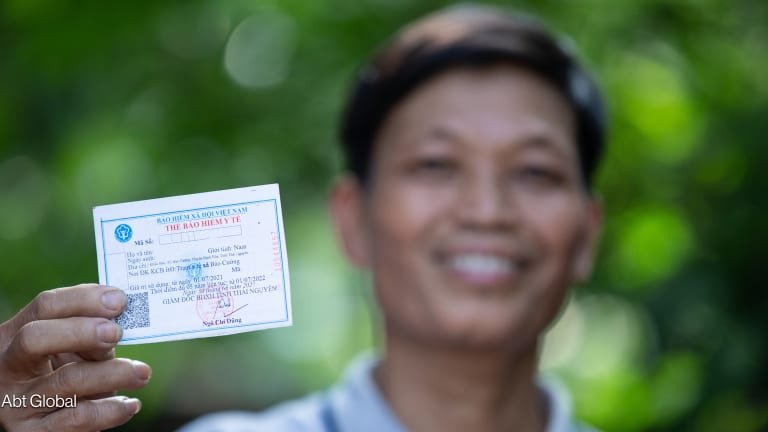
In early April, drugs for HIV treatment financed by PEPFAR reached Ukraine. But there’s another layer of challenge: distributing them to regions across the country. It’s no small feat given how parts of Ukraine remain in active war with Russia, and Russian soldiers have taken control of some areas, making deliveries difficult and at times close to impossible.
The must-read weekly newsletter for exclusive global health news and insider insights.
Many aid organizations rely on local NGOs for delivery. In the case of antiretroviral drugs, the U.S. President's Emergency Plan for AIDS Relief partnered with 100% Life to ensure the medicines are distributed within Ukraine. Meanwhile, the Alliance for Public Health, a partner of the Global Fund to Fight AIDS, Tuberculosis and Malaria, started distributing drugs for people under opioid agonist treatment.
The work is challenging, and at times life-threatening. In certain regions, or oblasts, deliveries are only possible with the help of volunteers. In particular areas, deliveries are being made secretly, and some NGOs would rather not discuss them for fear of jeopardizing the little openings they have to get medicines there, and to ensure the safety of their volunteers.
The people who turn ‘ARVs have reached Ukraine’ into ‘ARVs have reached the homes of all who need them’ are the civil society-led networks of everyday heroes.”
— Ben Phillips, director of communications, UNAIDSEvgeniya Rudenka, head of procurement at 100% Life, said that as of April 22, approximately 90,000 people in Ukraine have received the PEPFAR-financed ARV drugs, and the supply is enough for six months of treatment. There are an estimated 260,000 people living with HIV in Ukraine. Of that number, 152,000 were on ARV therapy before the war.
A lot of logistics companies don’t want to take the risks, but Rudenka said her organization was able to find a logistic partner able to make deliveries in locations with active fighting, such as in Mykolaiv and Sumy. But there are places where deliveries are “practically impossible,” such as in Donetsk, Kherson, and Luhansk. If they find opportunities to deliver lifesaving treatments to these dangerous places, they would need help securing cars to transport the medicines.
“Because companies of course do not want … their transport to be under the bullets … because no one will compensate [for] the damage [to the] car,” Rudenka said.
But resources are limited for local NGOs, not just for those delivering HIV services.
Of the roughly $1.2 billion humanitarian aid contributions paid or in process to date by governments for Ukraine, 67% is going to United Nations agencies, 10% to the International Committee of the Red Cross, 7% to international NGOs, and less than 0.1% directly to Ukrainian organizations, according to the U.N. financial tracking system as of last Friday, Abby Stoddard, founding partner of the international research consultancy, Humanitarian Outcomes, wrote in an emailed response to Devex.
Needs–funding mismatch
To assist local organizations, UNAIDS launched an appeal for $2.42 million to support local civil society organizations helping people living with HIV in Ukraine and in refugee-hosting countries. Ben Phillips, UNAIDS director of communications, said the overall need is greater, and hopes donors will provide more flexible funding given the extraordinary circumstances, he said.
“There are now ARVs in Ukraine. But that is not the same as ARVs being in the homes of all who need them. The people who turn ‘ARVs have reached Ukraine’ into ‘ARVs have reached the homes of all who need them’ are the civil society-led networks of everyday heroes who are taking them through,” Philips told Devex.
Donors need to put greater trust in them, as the “alternative risk is we see a resurgence of HIV and AIDS in Ukraine,” he said.
The funding isn’t only to deliver lifesaving medicines but to help these organizations address the other needs of people living with HIV, such as food and housing. CSOs also need additional financial support for administrative work, such as rent and the costs of service delivery, according to UNAIDS.
Andriy Klepikov, executive director of Alliance for Public Health, one of the largest NGOs in Ukraine focused on HIV and tuberculosis programs, told Devex the situation became even more difficult for many of the people they were assisting before the war. So in addition to the usual core package of services they provide, they’re also trying to assist these people in response to other needs, such as documentation, housing, transportation, or even evacuation. But he said resources are limited, as they are still working with the same level of resources as they did before the war.
“In such a situation, we are hoping that more resources will be provided, in addition to some flexibilities [already provided] by some donors like the Global Fund to Fight AIDS, Tuberculosis and Malaria,” he said.
The Global Fund invoked a 2016 policy allowing it to flexibly provide support in challenging operating environments such as that in Ukraine to ensure the continuity of lifesaving HIV and TB services by principal and subrecipients of Global Fund grants in the country, according to Darren Dorkin, the Global Fund’s portfolio manager for Ukraine.
The fund has also agreed to temporarily cover the cost of delivery of HIV prevention, care, and support services for key populations and people living with HIV in Ukraine until the third quarter of 2022. Before the war, these services were contracted by the Public Health Center of Ukraine to local CSOs, but the State Treasury of Ukraine has frozen funding for the programs.
These services are estimated to cost about $5 million from January to September 2022 and will come from Global Fund’s Ukraine grant, worth $180.7 million, for the period 2021-2023, according to Dorkin.
“Responding to the crisis in Ukraine requires a multi-faceted approach using all possible delivery and service channels, of which local NGOs/CSOs are a critical part,” said Dorkin.
The need to accept greater risks
Several international donors have pledged humanitarian assistance for Ukraine. But Stoddard said donors and the international organizations they partner with need to take steps to increase funding going directly to national and local entities, such as loosening some compliance requirements — meaning accepting a “greater risk of theft, loss, and diversion, and co-own these risks with their national partners.”
“The more critical and life-saving the aid activities, the more we need to raise the threshold of acceptable risk,” she said.
“As in every humanitarian emergency, especially those that are difficult and dangerous to operate [in], the international entities will subgrant to national organizations, but this takes time, and many of the new organizations do not have the capacity for the onerous compliance requirements that the international organizations demand,” she added.
The European Commission and its 27 member states, as well as Norway and Turkey, have given emergency assistance worth over €260 million ($273.7 million) for Ukraine, including health support. It has also given out financial assistance worth €130 million to humanitarian partners working in Ukraine, such as U.N. agencies, the Red Cross, and international NGOs that incorporate health support in their response, according to an EU spokesperson.
The EU spokesperson said, “many ECHO-funded humanitarian partners in Ukraine are working with local NGOs to deliver aid on the ground.”
A breakdown of Canadian humanitarian aid for Ukraine meanwhile is given to “experienced” humanitarian partners — the bulk of which to U.N. agencies or Canadian NGOs. But a spokesperson for Global Affairs Canada said funding channeled to the International Federation of the Red Cross and Red Crescent Societies as well as UNOCHA’s Ukraine humanitarian fund are expected to benefit local organizations.
Klepikov said local NGOs are closer to communities and people in need, and therefore “know the needs better and can help quicker.” But it “doesn’t matter” whether the money goes to local or international.
“My point is that money should work in a quickest and most effective way,” he said, as “managing their funding to Ukraine [donors] cannot continue business as usual.”









